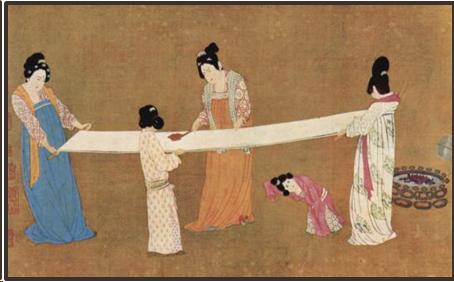

T'ang silk screening - Chinese women weaving silk
Here, I want to concentrate on the goods exchanged along the Silk Road. At the core of Silk Road commerce were a number of luxury goods, from which the most profit could be gained. Of course, the most obvious item traded was Chinese silk, for which the Road was named in the nineteenth century. In fact, into the late medieval period, China was the only country where cultivators and weavers had developed techniques for producing high-quality silk fabrics. Silk was such a highly sought-after and profitable commodity that the Chinese authorities imposed draconian controls on its production and manufacture, attempting to keep from everyone else the secret of its production. Silk is still considered a luxury good, and its high price still reflects not only its high status, but also that of the wearer. Why was silk so sought-after? There are three major reasons. The first is that silk is, in a nutshell, soft and pleasing to the touch. Its softness simply makes for excellent wearability. Second, silk has what we would call "climate control" qualities. That is, silk can keep one cool in summer and warm in winter, an attribute no other natural textile shares. The second reason for the status of silk is the fact that no other natural textile can achieve the color saturation which silk does. In other words, silk holds brighter colors for longer, a very desirable trait in a world in which every other textile could only achieve muted, drab colors. Of course, these three attributes made silk not only sought-after but expensive, which in turn made it affordable only to the upper classes. In a kind of socio-economic cycle, then, silk consequently became a mark of social standing differentiating those who could afford to wear it from those who could not. / While China's main export was silk, it was not the only one. The Chinese also manufactured and traded highly-sophisticated ceramics, known as porcelain or "china". Made of special clay and porcelain stone, Chinese ceramics were glazed in a special lacquer which allowed it to withhold higher temperatures while remaining light and delicate. "China" is also considered an art form, as the most sophisticated pieces were decorated with beautiful and delicate scenes, usually with stunning detail. The Chinese also exported jade (raw or carved) and tea. / The balance of trade definitely benefitted China over its trade partners. That is, China exported much more than it imported, making more money than it spent on commerce with the West. Nevertheless, several "Western" goods were highly sought-after in the East. Among these were glassware (particularly from Roman territories in the Near East and later from Venice), jewelry, perfumes, bronze goods, wool and linen textiles, pottery, iron tools, olive oil, wine, and gold and silver bullion (this last one particularly after the "discovery" of the New World and its seemingly bottomless silver mines). What is particularly interesting about trade from West to East is that Mediterranean merchants and manufacturers often imported raw materials, such as uncut gemstones, for the East, which they then exported as finished products in the form of expensive jewelry and decorative items. / What about trade in and between the areas sandwiched between Europe and China? In fact, any number of goods coming from any number of places was traded along the Silk Road. However, I want to highlight here three: horses (particularly from the Middle East), jade (particularly from the lands immediately to the west of China), and spices from the South East Asian islands which today make Indonesia. As you might already know, spices were the second best-selling commodity traded along the Silk Road. Spices were highly-sought after for several reasons. Perhaps most famously, spices serve as natural food preservatives, keeping food edible for longer periods of time, a particularly attractive attribute in a world with no refrigeration. Spices also flavor food, which makes it more palatable (and hides bad tastes in case of decomposition). However, spices served not just to preserve or season food; they can also be used as medicines, drugs, anesthetics, aphrodisiacs, perfumes, aromatics, and any number of potions. The trade of spices was so remunerative, in fact, that they were the reason for both the Portuguese and the Spanish to attempt to circumvent the usual middlemen and find their own route to the "Spice Islands". And, of course, this search for a new route to the East was what ultimately led to the "discovery" of the "New World".